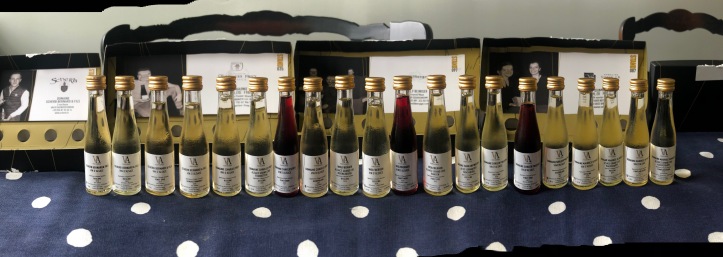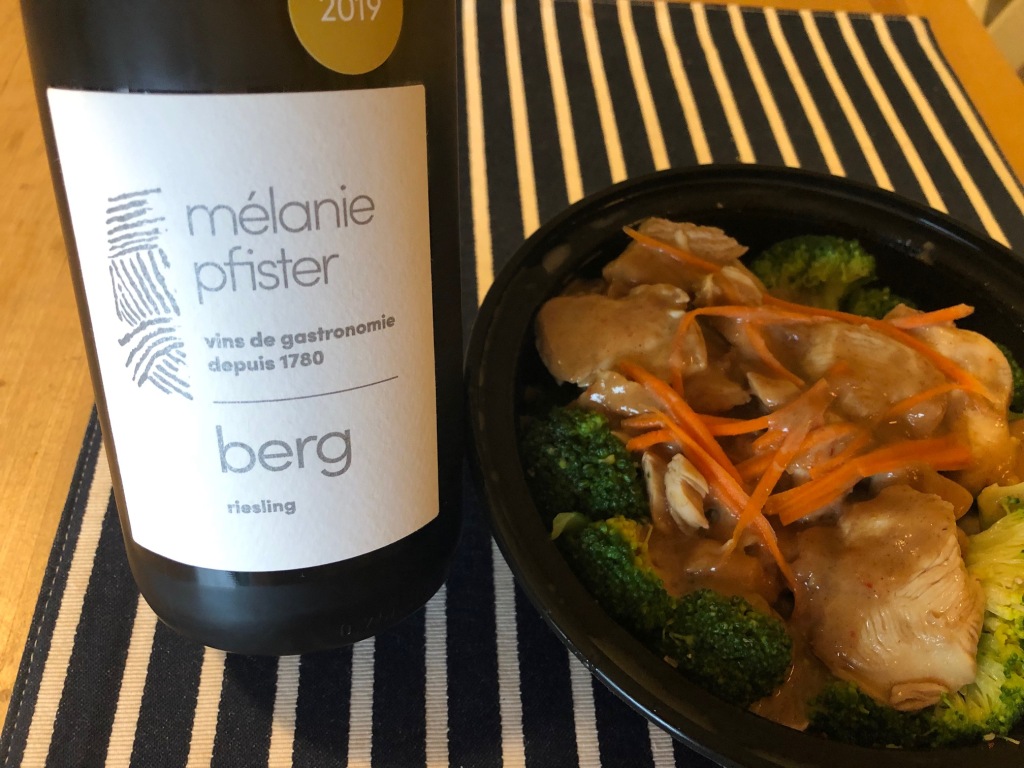
Do you love white wines? Me too, which is why I get excited about wines of Alsace! This year, the Vins d’Alsace, the official organization of the Alsace wine-growing region, got crazy creative. In past years, they have mounted a traveling expo with dozens of Alsace wine producers. I’ve been to the event in Chicago at least twice and it’s amazing – there are workshops and seminars, tastings, food pairings. It’s a cavalcade of information, education and yes – delicious Alsatian wines.
But then stupid Covid happened. And that put the ki-bosh on everything…. everything except the winegrowers of Alsace, that is! These people got creative and brought the expo to life online in the most amazing way.
See that crazy picture up top? I received five tiny boxes each containing four 20cl samples of different Alsace wines. I also got to sign up for one-on-one tasting sessions with producers and while I was only successful at scheduling one of these (oh, Safari … oh, technology … don’t get me started), I’m here to drop some knowledge about the wine of this glorious region, because if you like white wines, you want to find yourself some wines from Alsace, stat!

First, let’s get oriented. I always like maps so I have some geographical context about where in the where these wines come from. As you can see, Alsace is in the far eastern part of France, sort of butting up against Germany.
It’s a cold climate region (hence the zingy acidity you get in the wines) that cuts a 60-mile path north-to-south. It’s smushed in between the Vosges Mountains to the west and the Rhine River to the east. The Vosges Mountains block the rain and make the region really sunny.
Let’s talk grapes. The big daddy is Riesling, followed by Gewurztraminer, Pinot Gris, Muscat and Pinot blanc.
Let’s talk appellations. There are three types: Alsace AOC is the beginning tier, then you move up to Alsace Grand Cru and then Crémant d’Alsace (bubbles!)
I’m gonna say that if you like Sauvignon Blanc (a high-acid white), Pinot Grigio (same, with different flavors), Chablis (unoaked Chardonnay from Bourgogne), you are going to love the white wines of Alsace.
Dry Riesling Rules!
I’ll say it: not all Riesling is sweet! Riesling – whether it is from Alsace (mmmmm, yummy), New York’s Finger Lakes region, far northern Michigan, Germany or anywhere else – can be gloriously dry and delicious!
Forever – literally – since dinosaur times – Riesling has suffered a perception problem and I’m gonna go ahead and blame Blue Nun. Who remembers this brand? Very sweet, very German Riesling that attained popularity in the U.S. in the 1970s, just when Americans were starting to discover and drink wines. And Americans came to associate Riesling with sweet. GET OVER THAT!
Not all Riesling is sweet. I would even say that MOST Riesling is dry, not sweet. Okay, that’s the end of my Riesling rant – but please – if you take only one thing from this post, let it be that not all Riesling is sweet! Okay, moving on.
Now I think it would be crackers to talk about each and every wine that I tasted in my little boxes because that’s going to get really tedious. And look at these three beauties that I just received and haven’t had a chance to taste yet! (I’m cracking into one of them tonight with Cozy Noodle’s Rama Special Chicken, though).

And I hate to say it: I’m not clear on U.S. availability of any of these – except Maurice Schoech and Wolfberger – but I encourage you to ask your wine shop person about them. All three of the wines you see above though are widely available and you should drink them, because they are delicious!

As predicted, I got Thai take-out and the Mélanie Pfister berg Riesling 2019 ($25) was a DREAM! This is chicken with salty, spicy peanut sauce and broccoli (some people would call it boring, but I love it). The wine is a DRY Riesling that is super aromatic with that trademark, subtle petrol note and then a tidal wave of all sorts of apples, honey and a lemony explosion. It’s super dry but full-bodied and so, so good.
Also cool: this wine is a father-daughter project and I love that.
Okay, on to stories of some of the other delights I tasted:
Domaine Charles Frey – I got to hang out with Thiebaud Frey on June 8 during a video chat, which was really cool. The Frey family has been making wine in Alsace for 25 years. Their father, Charles, was a pioneer in the region, and they’ve got 20 hectares and Riesling rules the roost here. They farm biodynamically, which brings a huge sense of terroir to their wines. They also get some of their grapes from various Grand Cru vineyards, including Frankstein.
Domaine Philippe Sohler – I love their family story, as their winemaking goes back to 1964. They grew not only grapes but other agricultural products and today their two daughters are in charge of the wine growing and winemaking. They seem to practice regenerative farming, which protects the soils and helps combat greenhouse gases and I love that, too.
Domaine Maurice Schoech – Okay, this family has been farming grapes and making wine since 1650 – what? Crazy-cool. They are a boutique producer, from what I can tell of their website I really liked their “Contemplation” wines which are blends of Gewurtz (“ga-vertz,” as I Gewürztraminer), Riesling and Pinot Gris -driping with ripe apricots and honey. So good!
Domaine Scherb Bernard & Fils – This family has been making wine for four generations, and the most interesting was a “zero-sulfite” Riesling that was BONE DRY. Super interesting (and good with creamy cheeses and savory seafood dishes). Their Pinot Gris was all crisp caramel apple and lemon zing. Oops, somehow I started describing tasting notes…
Wolfberger – This not a small family-owned winery, but rather a large co-op of 450 winegrowers, which I find fascinating. I didn’t know Alsace had co-ops (which are pretty common in other European areas). Collectively, they turn out 13 million bottles of wine each year (equating to well over 1 million 9L cases!) Their wines were gorgeous, especially 2018 Grand Cru Muenchberg (that is the vineyard plot’s name).
Want to read more about Alsace wines? I’e got your covered. My friends from the French Winophiles have more articles to share! And we’re gathering on Twitter this Saturday, July 17 at 10 a.m. Central time to talk through our Alsace wine wonders. Find us with #winophiles. Salut everyone!
- 3 Rieslings from Alsace by Wine Predator
- All About the Wines of Alsace by Vino Travels
- Alsace Wine and Cold Poached Salmon with Sauce Verte (Green Mayonnaise) by Our Good Life
- Alsace Wines’ Heart and Soul – Land Sustainability, Family Tradition and Food Compatibility by Chinese Food and Wine Pairings
- Alsace Wines Shine with Summer’s Bounty Risotto by Food Wine Click!
- Blending Innovation and Tradition with Wines of Alsace by L’Occasion
- Butternut Squash Chickpea Curry with Wine from Alsace by Cooking Chat
- Domaines Schlumberger 2018 Pinot Blanc: A Delectable Grape Mutation + Criques de Pommes de Terre by Culinary Adventures with Camilla
- Five Winemaking women of Alsace by My Full Wine Glass
- Once Upon a Wine in Alsace by Wining With Mel
- Shrimp Louis Sandwiches paired with an Alsace Pinot Blanc by A Day in the Life on the Farm
- Summer Food Pairings with Alsace Wines by Always Ravenous
- Wines of Alsace Bring the Wow Every Time by What’s in that Bottle?
- Women of Alsace – conversations with 4 Women on their family wineries in Alsace by Crushed Grape Chronicles
- Zind Humbrecht Pinot Blanc with a Leek & Bacon Tart by Somm’s Table

[…] Wines of Alsace Bring the Wow Every Time by What’s in that Bottle? […]
LikeLike
I always love your topics, but my favorite thing is that when I am reading your posts I feel like I can hear your voice, like you are sitting across the table chatting with me about this wine! (Can’t wait to get to chat in person again soon!) I am a huge fan of Alsace and love that you are getting out the word that these are not Blue Nun (yep, I do remember that brand!)
LikeLike
Thanks, Robin! I can’t wait to sit across a table soon, too! Cheers!
LikeLike
It was daunting to try and figure out how to highlight all those tiny wines, right? You did a great job. And I was SO impressed with that digitasting, too. Cheers, Liz.
LikeLike
This was really an abundance of riches, right? But you’ve managed to organize it in the most un-tedious way possible! Loved the Philippe Sohler and Melanie Pfister wines.
LikeLiked by 1 person
[…] Wines of Alsace Bring the Wow Every Time by What’s in that Bottle? […]
LikeLike
[…] Wines of Alsace Bring the Wow Every Time by What’s in that Bottle? […]
LikeLike
YES, not all Riesling is sweet, not even in Germany! Loved the Digitasting and chatting with the estate owners. So many Alsace wines on my list to try, hunting them down is the hard part. I guess I need to take a trip to Alsace! Cheers!
LikeLike
[…] Wines of Alsace Bring the Wow Every Time by What’s in that Bottle? […]
LikeLike
Thai sounds like it would be the perfect accompaniment to many of these wines. It was hard to get a good feel for the little bottles, but I’m not done discovering Alsace yet. Great wines!
LikeLike